- | 8:00 am
443 feet and falling: why skyscrapers are adding slides, stairs, decks, and free falls
And why thrill-seekers around the world are flocking to them.
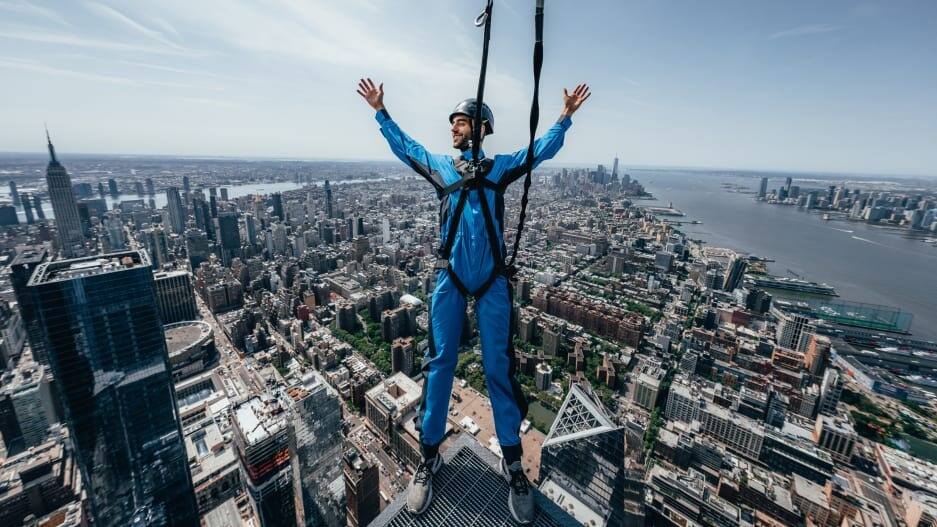
It’s an unmistakable and shocking sight: a human body falling from the top of a tall building. On a clear October day, tourists and commuters moving through Berlin’s central Alexanderplatz square may have caught this glimpse, a few seconds of terror as a man fell from the roof of the 41-story Park Inn hotel.
The man was Salvatore Escalante. “I was screaming. Then I had to take a breath, and kept screaming,” recalls Escalante, who survived the fall because it was not exactly a fall.
He was experiencing a tourist attraction called Base Flying, which offers people the opportunity to be held in a harness over the edge of a building and dropped. Escalante, who runs a tour agency in El Salvador, was in Berlin visiting his girlfriend and was taken to Base Flying as a birthday surprise. “She knew that I love adrenaline and she said, ‘I got the perfect gift for you,’” he says.
So on that clear, windless October day, Escalante was strapped onto a rope, taken out on a platform several feet from the edge of the 400-foot-tall building, and dropped into a free fall. After about 260 feet, an automated system kicked in and gradually slowed the rope, bringing him down to the ground smoothly.
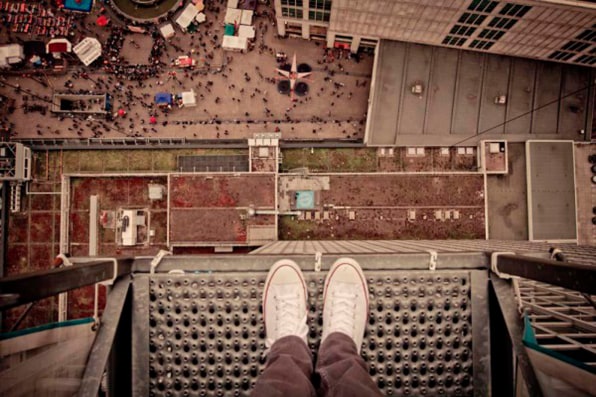
“Otherwise it would break all your bones, of course,” says Andreas Höfer, a manager for the Jochen Schweizer Gruppe, which created Base Flying in 2009. Founded by a former champion kayaker-turned-stuntman, the company operates thrill-based experiences across Germany, including bungee jumping from industrial cranes and rappelling face-first down the sides of buildings. The company had been looking to broaden its offerings.“We found an engineer who was really into winches and computer technology—and safety, luckily,” Höfer says. “He built the system from zero.” Now Base Flying drops about a thousand people a month from the top of the Park Inn hotel. With tickets running roughly $80 per person, Höfer says the business nets about $40,000 per month.
Base Flying is one of an increasing number of urban tourist experiences combining tall buildings and safe-but-still-scary thrills, satiating adventure-seekers like Escalante while earning their operators significant profits. It’s a growing niche in the tall-building industry as skyscrapers continue to rise in ever more parts of the world.
For pretty much the entire three-second fall from the top of the Park Inn, a Base Flying customer would have an unobstructed view of the Fernsehturm, Berlin’s iconic disco-ball television tower. Opened in 1969, it’s representative of an earlier era of skyscraper tourism, with an observation deck and a revolving restaurant.
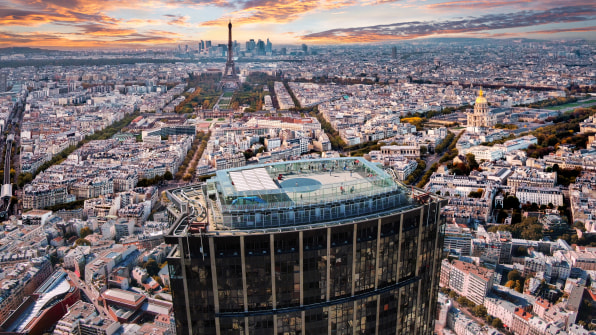
The TV tower is operated by Magnicity, a French company that runs tourist sites in landmark buildings around the world. The company got its start in 1974 when it bought the top floor of the Montparnasse Tower in Paris and turned it into an observation deck. This 56th-floor space offers what the company calls “the best view” of the Eiffel Tower—itself the site of the first urban observation deck, which opened in 1889.In recent years Magnicity has expanded; it now owns or leases space in four buildings in Europe and the U.S. In a typical, non-pandemic year, Magnicity’s sites see more than 3 million visitors, bringing in some $60 million in revenue.
“You can’t find many experts in this area,” says Magnicity CEO Alexia Vettier. “We believe we are, and we want to be, the leader of managing observation decks.”
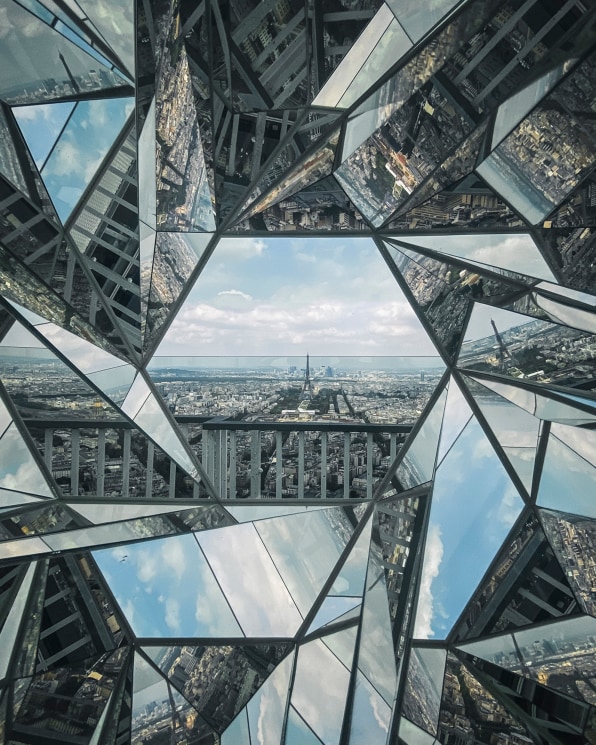
But just giving people a place to view the city is no longer enough. Vettier says Magnicity is putting more of its efforts into operating—and in some cases inventing—thrill-based skyscraper experiences.In Chicago, it operates Tilt, a platform on the 94th floor of the former John Hancock Center tower that tilts 30 degrees outward from the building, offering its eight occupants the experience of being suspended, face down, 1,030 feet over the streets of Chicago. Vettier says roughly 1.6 million people have experienced Tilt since it was added to the building in 2014, 45 years after its original construction.
More than half of those who pay to visit the more traditional observation deck in the tower also pay to be tilted. Skyscraper thrills are profitable, Vettier says, noting that the aim is to create more such attractions: “When we can build a thrill attraction, we do it.”

Increasingly, that means working with developers and architects before a building is even designed, and finding ways to integrate thrill-based experiences into the form of the building itself. Vettier points to 30 Hudson Yards in New York as a recent example: Both an observation deck and a thrill experience were designed into the project from its early days.A hundred floors up over the $25 billion Hudson Yards development is the Edge, a cantilevering outdoor observation deck that pokes out from the side of an office tower. Its sides are lined with clear glass windows that tilt slightly outward, and a large section of its 7,500-square-foot floor space is glass, giving visitors a straight-down view—or selfie background—of a 1,000-foot drop.
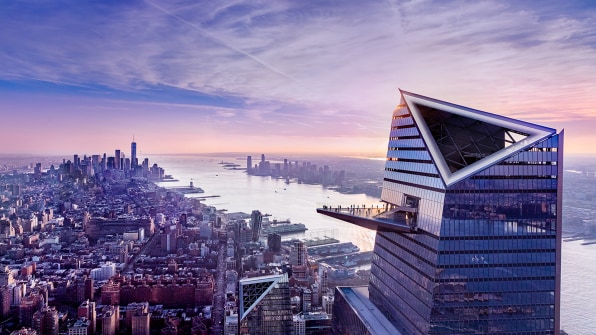
“We didn’t want it to just be on the top of a tall building. We wanted it to give that feeling of really floating over the city,” says Jason Horkin, VP of Hudson Yards Experiences, the company that operates the Edge. But they didn’t stop with the observation deck.“Very early on, there was a discussion that said, ‘Look if we’re going to be putting an attraction at the top of the building, what else can we do to differentiate ourselves? What else can we do that’s got a thrill factor?’”
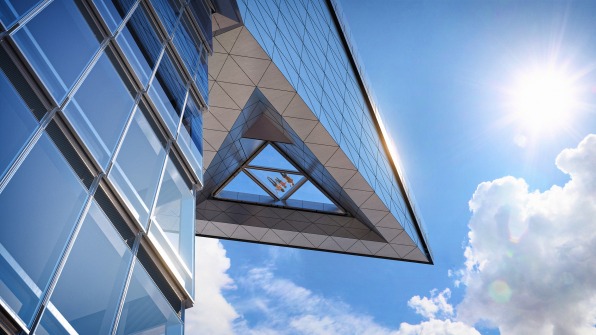
A design competition was launched to find out. The winning design was City Climb, a harnessed-in walk up the slanted roofline of the building. For $185, a visitor can don a jumpsuit and helmet, strap in, and walk up a staircase built into the top edge of the building. At its peak, 1,200 feet up, there’s a small platform where, with two harnesses attached, visitors can walk to the edge and lean over, as if taking a dive into a pool.
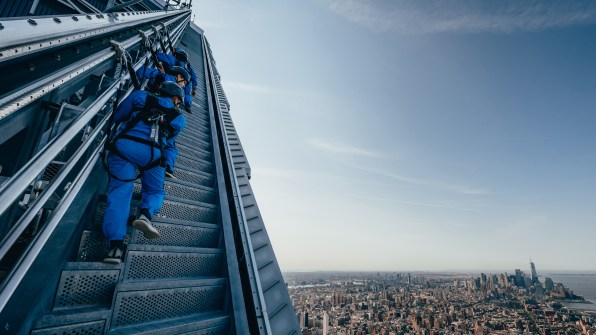
Horkin, who has done City Climb a couple dozen times, says it’s “for a smaller segment of the population” than the more straightforward Edge observation deck below, but one that thrill-seekers are happy to have access to.“It’s definitely designed to be a moneymaker,” he says (although he declined to offer revenue figures).
That’s not to say providing such offerings has been easy. Getting permits and approvals for City Climb added extra steps to the building’s development process. But Horkin says that piggybacking City Climb on top of the Edge means the two sites share much of the building infrastructure, such as access, a lobby, and bathrooms.
“If you had a building with nothing else at the top and you tried to do something like this, it would probably be prohibitive from a cost perspective as well as an approvals perspective,” he says. “Is it more complicated? Yes. Is it so complicated that it’s almost not worth doing? No.”
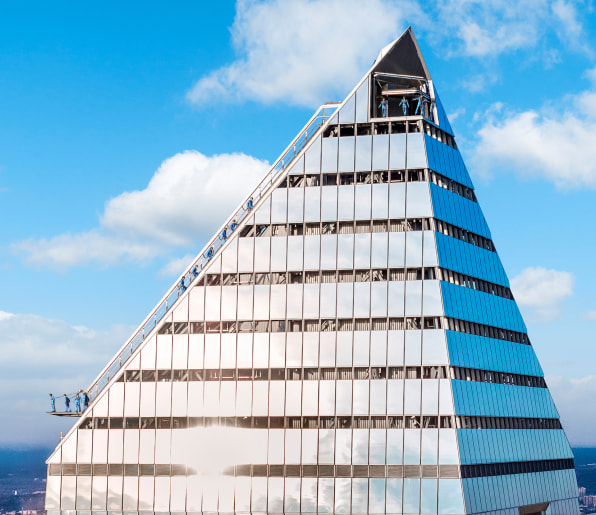
It also requires the right site; 30 Hudson Yards is tall enough and with few equally tall neighbors that it can offer a coveted 360-degree view of the city, on the Edge and an indoor observation area. On a clear day, a visitor can see the Statue of Liberty, Central Park, and Yankee Stadium—a boon for sight-tallying tourists.“From one vantage point you can see all the hits,” Horkin says. The building is also right in what Horkin calls the sweet spot in terms of height. “There is kind of a diminishing return on thrill and height,” he says. “If you get too high you lose touch with the fact that you are really on top of a building looking at the city.”
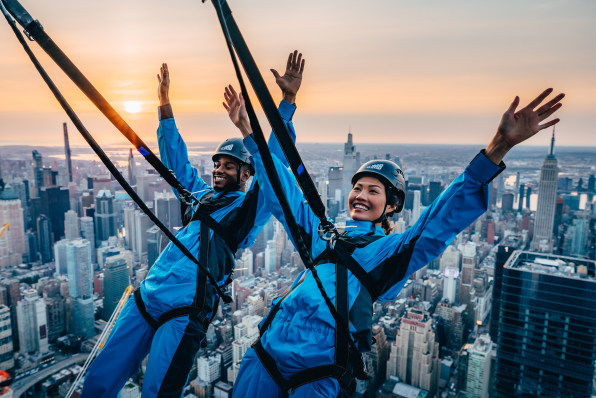
Back when the first observation deck was created in Paris in 1889, looking at the city was the entire point, simple as it may seem now. French literary theorist Roland Barthes argues in his 1964 essay “The Eiffel Tower” that its observation deck created an “architecture of vision,” allowing people to not just live in a city at ground level but to see and comprehend it from above, like the omniscient and extracted narrator of some urban guidebook.Seeing and thinking about the city from a great height is clearly not the novelty it once was. Davide Deriu is an architectural historian at the University of Westminster in London, and he says the experience economy may be partly to blame.
“The adventure tourism business has been incorporated into architecture,” says Deriu, who’s working on a book about the connection between the urban environment and the experience of vertigo. He points to all the marketing material for skyscraper thrills as “daring” customers to challenge their limits and face their fears.
Instead of being associated with Hitchcock-fueled anxiety, experiencing the great heights of buildings is now associated with accomplishment and bravery. “It’s become something desirable. It’s been turned and marketed as a thrill,” Deriu says.
The business side of building thrill-based features is hard to argue against. Deriu says many observation deck spaces often see visitors stay an average of only 20 minutes. “When you look at the actual turnover, they’re cash machines,” he says.
He connects this all back to the 1994 opening of a glass-floored section of the observation deck in Toronto’s CN Tower. Just about 250 square feet, a small window on the floor created a new kind of urban view—straight down from more than 1,100 feet. Dozens of buildings around the world followed with their own glass-floor viewing areas, particularly in the mid-2000s. This access to a previously impossible view may have opened some type of architectural floodgate.
Such elements are increasingly common, even in residential buildings. There are infinity pools that give the impression of swimming toward the end of the world, and glass-barriered condo balconies that seem to invite residents to walk straight out of their living rooms into the void.
“Maybe the point is to enjoy the ability of not falling, but you have to confront the idea that the fall is possible,” Deriu says, noting that the psychological impact of experiencing a skyscraper thrill is ripe for additional study.
“Until there was the very first glass floor on top of the CN Tower in Toronto, I don’t think anybody was screaming for that. Nobody desperately wanted a glass floor,” Deriu says. “Now it’s almost ubiquitous.”
New towers rising all around the world are creating more spaces for observation decks, and more opportunities to thrill. In Bangkok, the glass-floored observation deck of the MahaNakhon Tower sits 1,030 feet above the ground. In Dubai, the Sky Views Dubai tower features a glass slide attached to the outside of the building, starting more than 700 feet up. In Shanghai, the Jin Mao Tower features a rail-less exterior walkway around its 88th floor. Skyscraper thrills abound, and more are likely to develop.
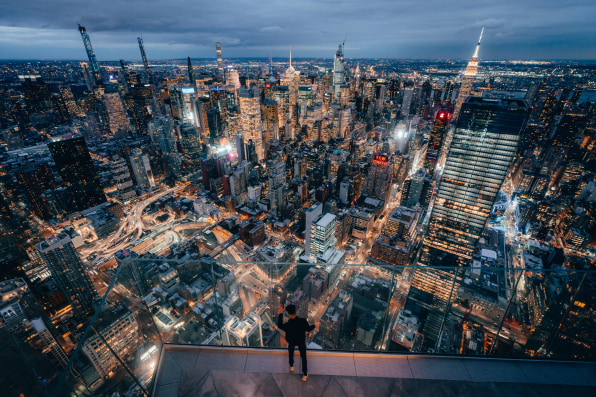
In New York, Horkin of Hudson Yards Experiences says a thrill experience like City Climb may be one of many coming to the city, though they’ll likely take a different shape. “New York can support a lot of things. Could it support another walk to the top of a building? Probably not,” he says. “Could it support some other thrill-type things? Probably.”Höfer of Base Flying in Berlin surmises that people are innately intrigued by heights and the chance of falling, so being able to access experiences that give the sense of falling without actually falling will always appeal.
“We are made to walk on the ground, and swim a little. But falling down is not our thing. We’d break some bones, or die,” he says. “That’s why it’s still scary, and that will never change.”





































